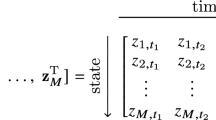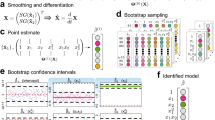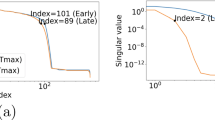Abstract
Data-driven discovery of differential equations relies on estimating model parameters using information about a solution that is often incomplete and corrupted by noise. Moreover, the sizes of the uncertainties in the model and data are usually unknown as well. This paper develops a likelihood-type cost function which incorporates both sources of uncertainty and provides a theoretically justified way of optimizing the balance between them. This approach accommodates missing information about model solutions, allows for considerable noise in the data, and is demonstrated to provide estimates which are often superior to regression methods currently used for model discovery and calibration. Practical implementation and optimization strategies are discussed both for systems of ordinary differential and partial differential equations. Numerical experiments using synthetic data are performed for a variety of test problems, including those exhibiting chaotic or complex spatiotemporal behavior.











Similar content being viewed by others
References
Ackleh Azmy S, Ferdinand Robert R, Simeon R (1998) Numerical studies of parameter estimation techniques for nonlinear evolution equations. Kybernetika 34(6):693–712
Ashyraliyev M, Jaeger J, Blom JG (2008) Parameter estimation and determinability analysis applied to drosophila gap gene circuits. BMC Syst Biol 2(1):83
Barajas-Solano David A, Tartakovsky Alexandre M (2019) Approximate Bayesian model inversion for pdes with heterogeneous and state-dependent coefficients. J Comput Phys 395:247–262
Barry RP, Pace RK (1999) Monte Carlo estimates of the log determinant of large sparse matrices. Linear Algebra Appl 289(1–3):41–54
Boutsidis C, Drineas P, Kambadur P, Kontopoulou E-M, Zouzias A (2017) A randomized algorithm for approximating the log determinant of a symmetric positive definite matrix. Linear Algebra Appl 533:95–117
Brunel NJB (2008) Parameter estimation of ode’s via nonparametric estimators. Electron J Stat 2:1242–1267
Brunton Steven L, Proctor Joshua L, Kutz J Nathan (2016) Discovering governing equations from data by sparse identification of nonlinear dynamical systems. Proc Natl Acad Sci 113(15):3932–3937
Brynjarsdottir J, O’Hagan A (2014) Learning about physical parameters: the importance of model discrepancy. Inverse Probl 30(11):114007
Croft W, Elliott CM, Ladds Graham SB, Chandrasekhar V, Cathryn W (2015) Parameter identification problems in the modelling of cell motility. J Math Biol 71(2):399–436
Cross MC, Hohenberg PC (1993) Pattern formation outside of equilibrium. Rev Mod Phys 65(3):851
Dewar MA, Kadirkamanathan V, Opper M, Sanguinetti G (2010) Parameter estimation and inference for stochastic reaction-diffusion systems: application to morphogenesis in D melanogaster. BMC Syst Biol 4(1):21
Evensen G (2009) Data assimilation: the ensemble Kalman filter. Springer, New York
Fullana JM, Le Gal P, Rossi M, Zaleski S (1997) Identification of parameters in amplitude equations describing coupled wakes. Phys D Nonlinear Phenom 102(1–2):37–56
Garvie MR, Maini PK, Trenchea C (2010) An efficient and robust numerical algorithm for estimating parameters in turing systems. J Comput Phys 229(19):7058–7071
Glasner K (2021) Optimization algorithms for parameter identification in parabolic partial differential equations. Comput Appl Math 40(4):1–22
Glasner K, Orizaga S (2016) Improving the accuracy of convexity splitting methods for gradient flow equations. J Comput Phys 315:52–64
Gugushvili S, Klaassen CAJ (2012) \(\sqrt{n}\)-consistent parameter estimation for systems of ordinary differential equations: bypassing numerical integration via smoothing. Bernoulli 18(3):1061–1098
Hager William W, Hongchao Z (2006) A survey of nonlinear conjugate gradient methods. Pac J Optim 2(1):35–58
Jin B, Maass P (2012) Sparsity regularization for parameter identification problems. Inverse Probl 28(12):123001
Kennedy MC, O’Hagan A (2001) Bayesian calibration of computer models. J R Stat Soc Ser B Stat Methodol 63(3):425–464
Kingma DP, Ba J (2014) Adam: a method for stochastic optimization. arXiv preprint arXiv:1412.6980
Liang H, Hulin W (2008) Parameter estimation for differential equation models using a framework of measurement error in regression models. J Am Stat Assoc 103(484):1570–1583
Long Z, Lu Y, Dong B (2019) Pde-net 2.0: learning pdes from data with a numeric-symbolic hybrid deep network. J Comput Phys 399:108925
Maddu S, Cheeseman BL, Sbalzarini IF, Müller CL (2019) Stability selection enables robust learning of partial differential equations from limited noisy data. arXiv preprint arXiv:1907.07810
Messenger Daniel A, Bortz David M (2021) Weak sindy for partial differential equations. J Comput Phys 443:110525
Plumlee M (2017) Bayesian calibration of inexact computer models. J Am Stat Assoc 112(519):1274–1285
Raissi M, Karniadakis GE (2018) Hidden physics models: machine learning of nonlinear partial differential equations. J Comput Phys 357:125–141
Raissi M, Perdikaris P, Karniadakis GE (2017) Machine learning of linear differential equations using gaussian processes. J Comput Phys 348:683–693
Raissi M, Perdikaris P, Karniadakis GE (2019) Physics-informed neural networks: a deep learning framework for solving forward and inverse problems involving nonlinear partial differential equations. J Comput Phys 378:686-707
Ramsay J, Hooker G (2017) Dynamic data analysis. Springer, New York
Ramsay JO, Hooker G, Campbell D, Cao J (2007) Parameter estimation for differential equations: a generalized smoothing approach. J R Stat Soc Ser B Stat Methodol 69(5):741–796
Reinbold Patrick AK, Gurevich Daniel R, Grigoriev Roman O (2020) Using noisy or incomplete data to discover models of spatiotemporal dynamics. Phys Rev E 101(1):010203
Rudy Samuel H, Brunton Steven L, Proctor Joshua L, Nathan KJ (2017) Data-driven discovery of partial differential equations. Sci Adv 3(4):e1602614
Sargsyan K, Huan X, Najm HN (2019) Embedded model error representation for Bayesian model calibration. Int J Uncertain Quantif 9(4)
Schaeffer H (2017) Learning partial differential equations via data discovery and sparse optimization. Proc R Soc A Math Phys Eng Sci 473(2197):20160446
Schaeffer H, McCalla SG (2017) Sparse model selection via integral terms. Phys Rev E 96(2):023302
Sgura I, Lawless AS, Bozzini B (2019) Parameter estimation for a morphochemical reaction-diffusion model of electrochemical pattern formation. Inverse Probl Sci Eng 27(5):618–647
Trefethen LN (2000) Spectral methods in MATLAB, vol 10. SIAM, Philadelphia
Voss Henning U, Jens T, Jürgen K (2004) Nonlinear dynamical system identification from uncertain and indirect measurements. Int J Bifurcat Chaos 14(06):1905–1933
Wang Z, Huan X, Garikipati K (2019) Variational system identification of the partial differential equations governing the physics of pattern-formation: Inference under varying fidelity and noise. Comput Methods Appl Mech Eng 356:44–74
Xu H, Chang H, Zhang D (2019) Dl-pde: deep-learning based data-driven discovery of partial differential equations from discrete and noisy data. arXiv preprint arXiv:1908.04463
Yoshinaga N, Tokuda S (2020) Bayesian modelling of pattern formation from one snapshot of pattern. arXiv preprint arXiv:2006.06125
Zhao H, Storey BD, Braatz RD, Bazant MZ (2020) Learning the physics of pattern formation from images. Phys Rev Lett 124(6):060201
Zhao H, Braatz RD, Bazant MZ (2021) Image inversion and uncertainty quantification forconstitutive laws of pattern formation. J Comput Phys 436:110279
Acknowledgements
The author was supported through NSF award DMS-1908968.
Author information
Authors and Affiliations
Corresponding author
Additional information
Communicated by Vinicius Albani.
Publisher's Note
Springer Nature remains neutral with regard to jurisdictional claims in published maps and institutional affiliations.
Rights and permissions
Springer Nature or its licensor (e.g. a society or other partner) holds exclusive rights to this article under a publishing agreement with the author(s) or other rightsholder(s); author self-archiving of the accepted manuscript version of this article is solely governed by the terms of such publishing agreement and applicable law.
About this article
Cite this article
Glasner, K. Data-driven learning of differential equations: combining data and model uncertainty. Comp. Appl. Math. 42, 36 (2023). https://doi.org/10.1007/s40314-022-02180-y
Received:
Revised:
Accepted:
Published:
DOI: https://doi.org/10.1007/s40314-022-02180-y




